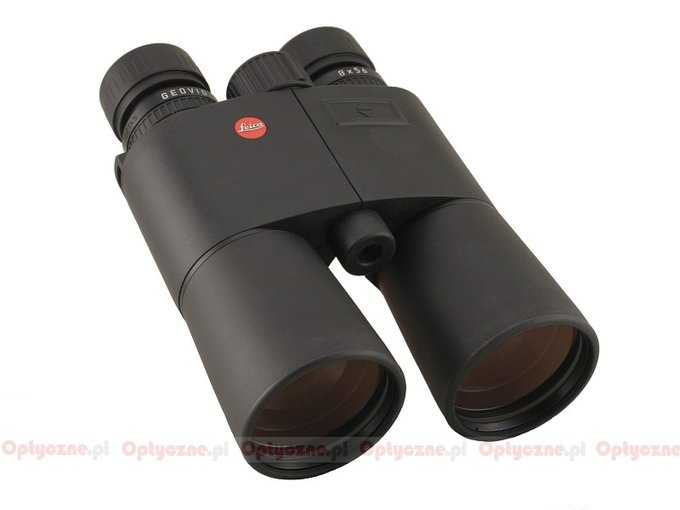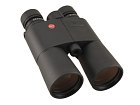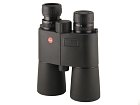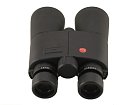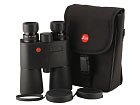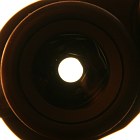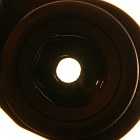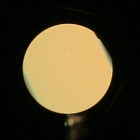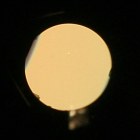Leica Geovid 8x56 BRF
Every hunter or amateur astronomer is aware that a classic night set of binoculars is an instrument with the objective lens diameter of 56-63 mm. While Zeiss and Swarovski have offered such products for a long time, up to 2005 the biggest binoculars on Leica’s offer had the diameter of barely 50 mm. That situation changed at the end of 2005 and at the beginning of 2006, when the Leica Geovid 8x56 BRF and 15x56 BRF models were launched.
At the moment the Geovid series consists of four roof-prism models in the Schmidt –Pechan system with such parameters as: 8x42, 10x42, 8x56 and 15x56. All of them are equipped with range-finders. The binoculars’ barrels are made of aluminum alloys, they are nitrogen-filled and fully watertight down to a depth of five meters.
| Magnification | Lens diameter | Angular field of view | Prisms | Eye relief | Weight | Price |
|---|---|---|---|---|---|---|
| 8 | 56 | 119/1000(6.8o) | BaK-4/roof | 18.5 mm | 1100 g | 11159 PLN |
Summary
Pros:
- solid but, at the same time, small and compact housing for such an equipment class,
- negligible astigmatism,
- slight coma,
- chromatic aberration corrected very well,
- slight brightness loss at the edge of the field,
- sharp image almost to the same edge of the field,
- low internal flares,
- slight distortion,
- a range-finder useful even at night.
Cons:
- too small prisms and truncated, darkened pupils as a result,
- low transmission in the red spectrum,
- objective lenses are closer to 55 mm than to 56,
- electronic elements of the range-finder aren’t darkened so they are visible in the inner tube,
- very high price.
Let’s deal with the parameters first. What’s the difference between the new Leica and its most serious rivals: a Swarovski SLC New 8x56 and a Zeiss Victory 8x56 T* FL? Just one glance at
this chart with an appropriate comparison
can reveal several substantial differences. One of the more important parameters of a set of binoculars is its field of view. Most of 8x56 class binoculars are characterized by a field of view level of 6.0-6.5 degrees. The values presented by “the holy trinity” are higher so they deserve our recognition. The result of 7.4 degrees, reached by the Zeiss, is unrivalled in its class. The Swarovski fares the worst here and the Leica is a bit better giving us the field of 6.8 degrees.
The next parameter, especially important if you wear glasses, is eye relief. Here, the order is reversed. The Swarovski fares the best with the result of 22 mm, the second place goes to the Leica again, which gives us 18.5 mm, and the worst performer is the Zeiss with the result of just 16 mm.
Everything looks even differently when it comes to the weight and the dimensions. It is difficult to manufacture a pair of binoculars which is small and optically good at the same time. Leica decided to undertake such a task and its instrument is indeed one of the smallest devices in the 8x56 class. The Leica is more than 100 grams lighter than the Zeiss and the Swarovski and significantly smaller than them (the difference in length reaches even more than three centimeters). When we take into account that the Leica is additionally equipped with a battery-powered laser range-finder, its small dimensions become even more impressive. You can be made aware how small exactly the Leica is when you look at the picture below, where it is placed next to a Docter 8x58.
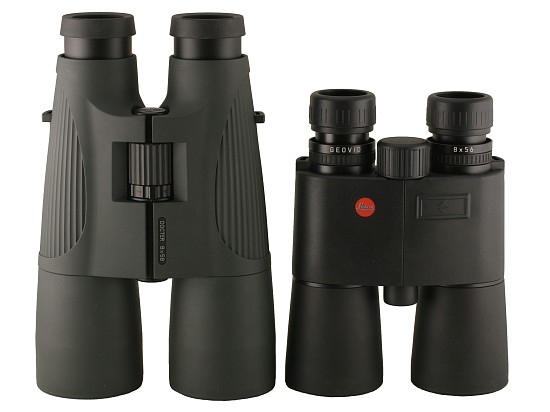 |
As we already mentioned the range-finder, let’s dedicate it a moment or two. The fact that. among other branded products. only Leica offered its customers a night set of binoculars with an in-build range-finder, which works also at night, is worth emphasizing. The range-finder constructions of Swarovski and Zeiss belong to the class of 30-45 mm small day binoculars. In the case of competitors if you want to have a range-finder and a night pair of binoculars you have to buy two devices and nobody guarantees such a tandem will work at night (Disclamer: this test was orginally published at Optyczne.pl before the moment of introducing Zeiss Victory 8x56 T* RF model)
In the case of the Leica, the range-finder fares well during the day and at night. It works quickly (the time of measurement taking doesn’t exceed one second) and accurately. Its working distance range is 1200 meters and it is accurate to 1 meter in the distance up to 350 meters, to 2 meters in the distance up to 700 meters and 0.5% for longer distances. Its work is comfortable. After pressing a rubber-coated switch, situated on the left inner tube, in the field of view centre appears a small red rectangle which is used to choose the measurement target. The second pressing of the switch results in taking a measurement and displaying the result under the rectangle. It is worth adding that the brightness of the displayed info is automatically adjusted to the observation conditions so it is higher during the day and lower at night – it doesn’t spoil the dark adaptation of your eyes. The range-finder is powered by just one CR2 battery and the producer claims it is enough for about 1000 measurements.
When writing about the dimensions and weight we must add something about the build quality and the materials used. The binoculars’ housing is made of die-cast aluminum, resistant to temperature changes so the instrument can be used in the temperature range of –15 to 55 degrees and stored from –40 to85 degrees Centigrade. The binoculars are covered by black anti-skidding material which clings to hands well. The barrel is completely watertight down to a depth of five meters and nitrogen-filled to boot.
The range-finder is situated between the inner tubes, where, in the case of many other instruments, is a place for a tripod exit, so if we want to put the Leica on a tripod we must buy a special brand-name adapter.
The eyepieces are covered by sliding eyecups made of plastics which are comfortable to look through. What’s rare, every eyepiece has its own individual focus ring and additionally, in the middle, there’s a central focus screw. Everything is well-damped and allows precise movements.
Although all the three binoculars, described here, were constructed in the roof-prism system we can find differences also in this category. Zeiss, already classically for that company, equipped its device with the Abbe-Koenig prisms which work is based on the total internal reflection phenomenon so you can avoid any transmission loss. Leica and Swarovski decided to use smaller and lighter Schmidt-Pecham prisms which demand a special reflection surface. The surface must be of a very high class indeed to minimize the light loss. Additionally, a phase correction coating must be applied on roof prisms. In the case of the Leica a P40 coating was used.
Apart from the prisms, every pair of binoculars consists of objective lenses and eyepieces. In the case of the Leica, the former are made of two elements, the latter – of five elements. The construction is complemented by additional focusing lenses, put between prisms and objectives. Every air-to-glass surface is covered by Leica HDC anti-reflection coatings.
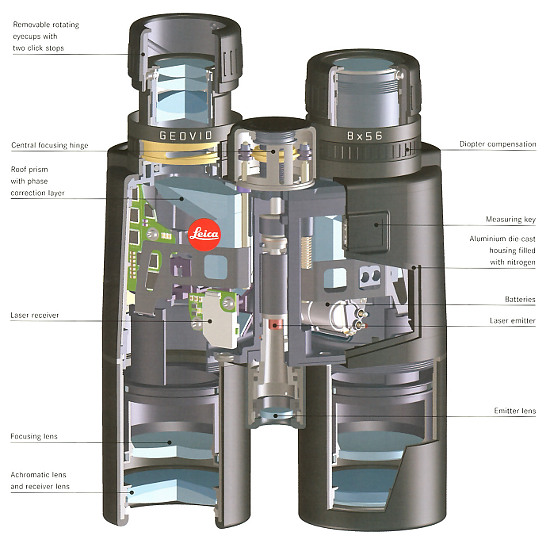 |
When it comes to the coatings, when we look at them from the side of the objectives they are deep red with disturbingly high intensity. It might suggest that the binoculars’ transmission in the red part of the spectrum is not the highest. Fortunately we don’t have to base on the colour of the coatings alone because we can consult a transmission graph, obtained using a spectrophotometer. It is presented below.
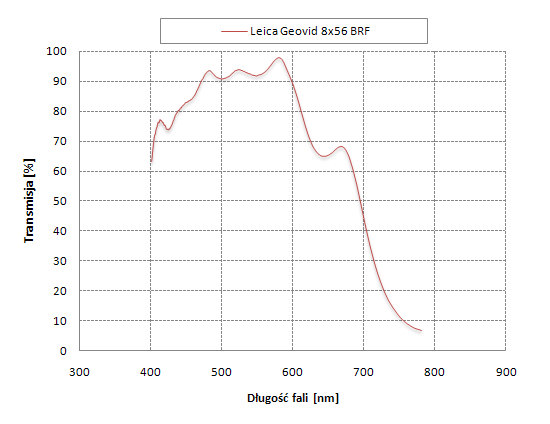 |
We have no objections about the transmission level in the visible spectrum centre, where it amounts to 93%. The red part of the spectrum is a problem, though. From 600 nm the transmission starts to decrease very sharply and because of that its average value in the red part of the spectrum amounts to just 52%. It is really low! The result ill befits such an optics legend as Leica. You can’t exclude a possibility that the shape of the transmission graph is caused by the presence of the range-finder based on an infrared laser.
How does it all perform in practice? We can say: typically for a Leica so very well. The image is clear, with high contrast and outstanding sharpness in the centre. The binoculars have very low astigmatism, negligent chromatic aberration, which increases in an acceptable way at the edge, and slight coma. They work very well at night and against bright light, without showing any noticeable flares. The image border is just a bit darkened and very slightly blurred. In fact, these are the only inconveniences caused by saving on prisms dimensions. The effect of that saving can be seen directly in the form of slightly truncated exit pupils.
We left the price for the very end – it is not low, as it is often the case with Leica,. Not so long ago for a Geovid 8x56 you had to pay about 8000 PLN. After the latest currency turbulences the price skyrocketed to 11000 PLN! It is really a huge amount of money, especially if for the rival products of Zeiss and Swarovski we must pay significantly less. On the other hand, though, in the case of the Leica apart from compact dimensions we also get a build-in range-finder – if we bought a competitor’s product, we would have to purchase it additionally.




